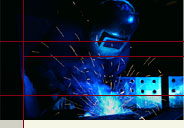
I have an aftermarket racing radiator and an aluminum lower radiator pipe from Z1 Motorsports. The stock rubber lower radiator pipe is a mile long, has two right angle bends, and is considered a weak link during wide open throttle runs when it can collapse and cause overheating. I had experienced this on the track and my lower aluminum hardpipe cured the problem. Aluminum replaced rubber.
I later developed a couple of leaks in my hardpipe for reasons described below. I still recommend the hardpipe, just don't let my mistakes happen to you.
First leak occurred many months later when I noticed my temperature gauge slowly creeping up on a routine drive. Made it home. As soon as I opened my door I could smell the sweet odor of antifreeze. Despite the many criticisms toward the stock gauges, my temp gauge worked admirably in this situation, was sensitive to a relatively small amount of coolant loss and prevented a potentially serious overheating scenario.
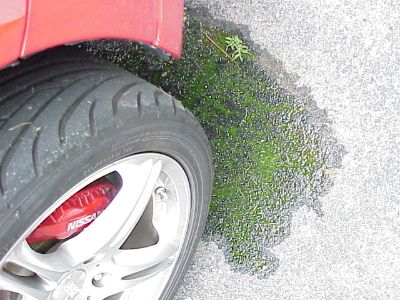 Yuck, the right front corner looked like this after being parked for a short time. The tell-tale color and "sickly-sweet" smell is characteristic of anti-freeze. Very toxic stuff if ingested, a couple of ounces will kill a child or dog if ingested. Dogs will lap it up if thirsty. Yuck, the right front corner looked like this after being parked for a short time. The tell-tale color and "sickly-sweet" smell is characteristic of anti-freeze. Very toxic stuff if ingested, a couple of ounces will kill a child or dog if ingested. Dogs will lap it up if thirsty.
Put the front end of my car up on jackstands, removed the splash shield, crawled underneath and found this -
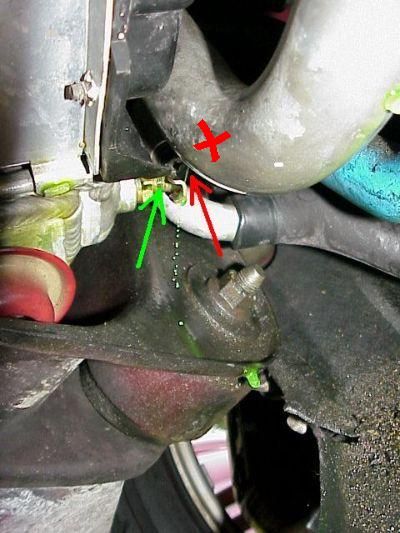 The red X is the lower radiator hardpipe. The bend is at the passenger's side corner of the bottom of the radiator. The red arrow shows coolant leaking out of the hardpipe. The green arrow is on the brass petcock, which was banging into the hardpipe every time I went over a bump. Eventually, the petcock wore a hole through the soft, aluminum, hardpipe. The red X is the lower radiator hardpipe. The bend is at the passenger's side corner of the bottom of the radiator. The red arrow shows coolant leaking out of the hardpipe. The green arrow is on the brass petcock, which was banging into the hardpipe every time I went over a bump. Eventually, the petcock wore a hole through the soft, aluminum, hardpipe.
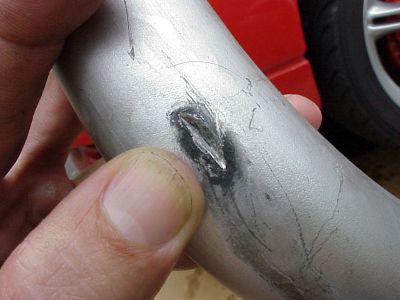 Here's the gouge the petcock made on the hardpipe, up close. Here's the gouge the petcock made on the hardpipe, up close.
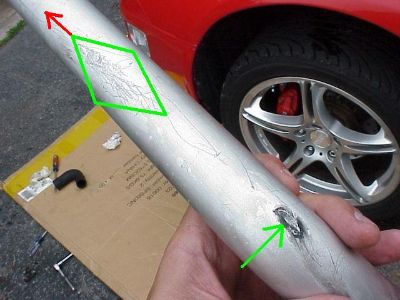 Once I pulled the pipe, I found TWO contact points that were wearing through. The leak shown above is by the green arrow. Another broader contact area is inside the green diamond. The red arrow points toward the top of the pipe that connects to the engine block. Once I pulled the pipe, I found TWO contact points that were wearing through. The leak shown above is by the green arrow. Another broader contact area is inside the green diamond. The red arrow points toward the top of the pipe that connects to the engine block.
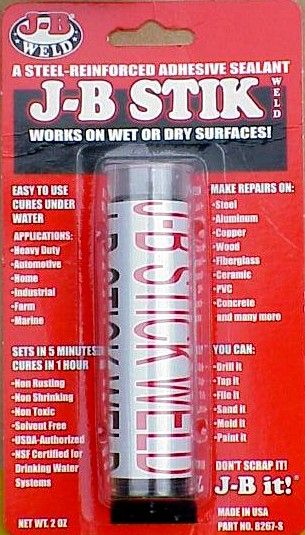 I used this product to plug the pinhole sized leak. The instructions stated that it would plug up to a dime sized hole. Plus, it only took an hour to dry and I trusted the J-B name. I used this product to plug the pinhole sized leak. The instructions stated that it would plug up to a dime sized hole. Plus, it only took an hour to dry and I trusted the J-B name.
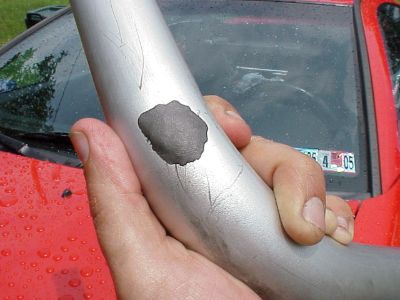 Before applying the patch, I baked the pipe dry in an oven at ~200 degrees F, then cleaned it with a wire brush and brake cleaner spray. This patch has held up to repeated track use after being repaired in late 2003. Before applying the patch, I baked the pipe dry in an oven at ~200 degrees F, then cleaned it with a wire brush and brake cleaner spray. This patch has held up to repeated track use after being repaired in late 2003.
By simply shoving the hardpipe further into its connecting elbows on both ends, I was able to get the pipe installed inside the petcock, so that it didn't rub anymore.
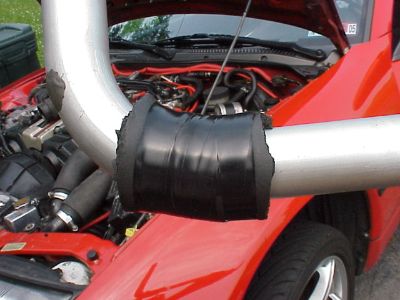 I padded the pipe as shown with plumbing pipe insulation and electrical tape. This completely eliminated the annoying clunk I was hearing for months when I went over bumps. I thought it was my suspension but it was this pipe banging on the radiator all along. I padded the pipe as shown with plumbing pipe insulation and electrical tape. This completely eliminated the annoying clunk I was hearing for months when I went over bumps. I thought it was my suspension but it was this pipe banging on the radiator all along.
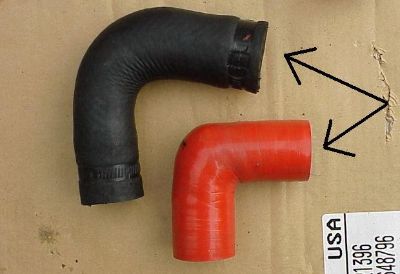 Almost two years later I developed another leak in a connecting elbow. I had originally bought two silicone red Turbohoses to connect the upper and lower ends of the hardpipe to the car. The lower Turbohose fit, after some trimming, but the upper elbow would not fit Almost two years later I developed another leak in a connecting elbow. I had originally bought two silicone red Turbohoses to connect the upper and lower ends of the hardpipe to the car. The lower Turbohose fit, after some trimming, but the upper elbow would not fit
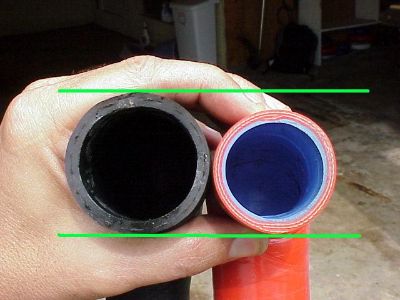 because of the size difference shown here. So I ended up using a cut-off piece from my original 1992 rubber OEM lower radiator hose I had already removed. I meant to change out this orginal piece of hose with a new one, but guess what, I forgot about it :c( because of the size difference shown here. So I ended up using a cut-off piece from my original 1992 rubber OEM lower radiator hose I had already removed. I meant to change out this orginal piece of hose with a new one, but guess what, I forgot about it :c(
The piece of original black hose gave out on me from age several months later. I bought a brand new OEM lower radiator hose just so I could cut the end off and use it as a connecting elbow.
Now here's the strange part. Once I got the old piece of hose off, I found ANOTHER split in it, on the top side of the hose, such that the coolant would not completely leak out and the cooling system would not hold pressure, either.
By replacing the old split leaky piece of hose, my cooling system was once again pressurized and my car instantly and noticeably ran much smoother. My guess was that the engine temp sensor was not getting an accurate reading when the hose was split, due to the coolant level being down just enough, but not enough to cause overheating. Interesting to note that changing or adding coolant is one of the steps on the famous TT.net "Why Does my z32 Hesitate Sometimes?"
| 